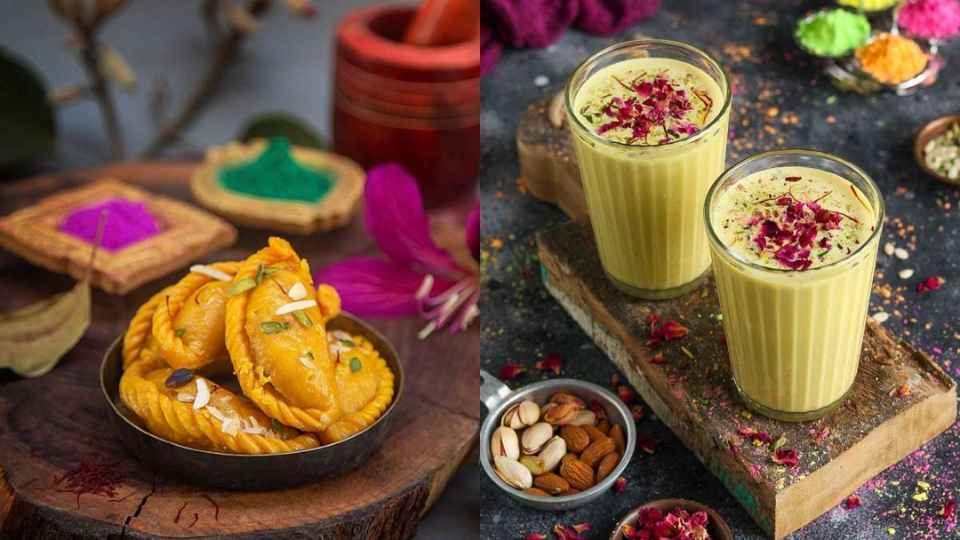Holi 2024: Gujiya to Thandai, 5 Traditional Holi Recipes That Will Make You Drool
As the vibrant festival of colors, Holi, approaches, it’s time to delve into the rich culinary traditions that accompany this joyous occasion. Holi isn’t just about smearing colors on each other; it’s also about coming together with loved ones and indulging in mouthwatering delicacies. From sweet to savory, Holi recipes offer a diverse range of flavors that reflect the cultural diversity of India. In this blog post, we’ll explore five traditional Holi recipes that are sure to tantalize your taste buds and add an extra dose of sweetness to your celebrations.

Gujiya:
Gujiya, the quintessential Holi delicacy, holds a special place in the hearts and taste buds of people celebrating the festival of colors across India. This sweet treat is not just a dessert but a symbol of joy, togetherness, and the arrival of spring. Let’s delve deeper into what makes Gujiya such an integral part of Holi celebrations:
1. Tradition and Symbolism: Gujiya is steeped in tradition and symbolism, making it an essential component of Holi festivities. The crescent shape of Gujiya symbolizes the moon and is associated with Lord Krishna, who is often depicted playing Holi with his beloved Radha. Thus, Gujiya holds cultural and religious significance, adding depth to the celebration.
2. Ingredients and Preparation: The process of making Gujiya involves a labor of love, with each step contributing to its irresistible taste and texture. The outer shell is made from a dough of all-purpose flour, ghee (clarified butter), and water, which is then rolled out and filled with a decadent mixture of khoya (reduced milk), finely chopped nuts like almonds, pistachios, and cashews, as well as aromatic spices such as cardamom and nutmeg. To enhance the sweetness, sugar or powdered jaggery is added to the filling. The Gujiyas are then carefully sealed and shaped into crescents before being deep-fried until golden brown.
3. Taste Sensation: The magic of Gujiya lies in its harmonious blend of textures and flavors. The crispness of the fried outer shell contrasts beautifully with the soft, creamy filling, creating a symphony of sensations with every bite. The richness of the khoya, the crunch of the nuts, and the sweetness of the sugar come together to create a taste sensation that is both indulgent and satisfying. Each Gujiya is a perfect balance of sweet and savory, making it impossible to stop at just one.
4. Presentation and Serving: No Gujiya is complete without a generous dusting of powdered sugar, which adds a final touch of sweetness and enhances its visual appeal. Whether served warm or at room temperature, Gujiya is best enjoyed with a steaming cup of masala chai or a refreshing glass of Thandai, further elevating the culinary experience.
5. Sharing Joy and Togetherness: Beyond its delicious taste and aesthetic appeal, Gujiya embodies the spirit of sharing and togetherness that defines Holi celebrations. Families and friends come together to prepare Gujiya, sharing laughter, stories, and culinary secrets along the way. The act of offering and exchanging Gujiyas symbolizes love, friendship, and the joy of being together during this festive season.
Thandai:
Thandai, a beloved traditional Indian beverage, holds a significant place in Holi celebrations, offering a refreshing respite from the vibrant chaos of colors and the heat of the season. Let’s delve deeper into the essence of Thandai and why it’s a must-have during Holi:
1. Ancient Origins and Cultural Significance: Thandai has roots tracing back to ancient India, where it was consumed for its cooling properties during the scorching summers. It is closely associated with festivals like Holi and Mahashivratri, where it is offered as a sacred drink to Lord Shiva and Goddess Parvati. Its association with Holi adds an extra layer of festivity and tradition to the celebration.
2. Ingredients and Preparation: The essence of Thandai lies in its blend of wholesome ingredients, carefully chosen for their flavor and cooling properties. A typical Thandai recipe includes milk as its base, infused with a mixture of nuts such as almonds, cashews, and pistachios, which are soaked, ground, and strained to extract their essence. Aromatic spices like cardamom, saffron, fennel seeds, and black peppercorns are added to enhance the flavor profile and provide a refreshing twist. Some variations may also include poppy seeds and dried rose petals for added depth of flavor.
3. Cooling Properties: One of the key reasons Thandai is so popular during Holi is its cooling effect on the body. The combination of milk, nuts, and spices not only provides essential nutrients but also helps to lower body temperature, making it an ideal beverage to combat the heat and dehydration often experienced during outdoor festivities. Additionally, the inclusion of ingredients like fennel seeds and rose water aids in digestion, further enhancing its health benefits.
4. Flavor Profile and Customization: Thandai boasts a rich and indulgent flavor profile, characterized by the creamy texture of milk, the nuttiness of the blended nuts, and the aromatic notes of the spices. The addition of rose water lends a subtle floral aroma, while crushed pistachios sprinkled on top add a delightful crunch. Thandai can be customized to suit individual preferences, with variations in spice levels and sweetness to cater to diverse palates.
5. Symbol of Hospitality and Celebration: In addition to its culinary appeal, Thandai serves as a symbol of hospitality and celebration during Holi. It is often prepared in large batches and offered to guests as a gesture of welcome and goodwill. Sharing a glass of Thandai with loved ones fosters a sense of camaraderie and joy, enhancing the spirit of togetherness that defines Holi celebrations.
Puran Poli:
Puran Poli, originating from the state of Maharashtra in India, is a traditional sweet delicacy that holds a cherished place in Holi celebrations and various other festive occasions. Let’s explore the rich heritage and irresistible flavors of Puran Poli:
1. Cultural Heritage and Regional Significance: Puran Poli is deeply rooted in the culinary traditions of Maharashtra and is often prepared during festivals, weddings, and other auspicious occasions. It is considered a symbol of warmth, hospitality, and familial bonds, reflecting the rich cultural heritage of the region. The preparation and consumption of Puran Poli are often accompanied by rituals and ceremonies, further emphasizing its significance in Maharashtrian culture.
2. Ingredients and Preparation Technique: The preparation of Puran Poli involves a meticulous process that requires patience and skill. The dough is typically made from whole wheat flour, water, and a hint of oil or ghee, kneaded to achieve a soft and pliable consistency. The filling, known as ‘Puran,’ is made from cooked chana dal (split Bengal gram), jaggery (unrefined cane sugar), and a blend of aromatic spices such as cardamom, nutmeg, and saffron. The cooked dal mixture is mashed and combined with jaggery and spices to create a smooth and luscious filling. The dough is then rolled out thin, filled with the sweet Puran mixture, sealed, and carefully cooked on a griddle until golden brown and crispy on the outside.
3. Texture and Flavor Profile: The hallmark of Puran Poli lies in its melt-in-your-mouth texture and harmonious blend of flavors. The outer layer of the flatbread, cooked to golden perfection, offers a crisp contrast to the soft and succulent filling within. The sweetness of the jaggery, infused with the earthy notes of chana dal and the warmth of aromatic spices, creates a flavor profile that is both comforting and indulgent. Each bite of Puran Poli is a symphony of textures and tastes, leaving a lingering sense of satisfaction and contentment.
4. Symbolism and Festive Tradition: Puran Poli holds symbolic significance in Maharashtrian culture, representing prosperity, abundance, and auspicious beginnings. It is often prepared as an offering to deities during religious ceremonies and shared among family and friends as a gesture of goodwill and unity. During Holi, Puran Poli is a must-have treat, enjoyed by people of all ages as they come together to celebrate the spirit of the festival.
5. Versatility and Adaptability: While Puran Poli is traditionally sweet, variations of this delicacy can be found across different regions of India, with savory fillings such as coconut, lentils, or vegetables. This versatility allows Puran Poli to adapt to diverse tastes and preferences while retaining its essence as a beloved comfort food.
Bhang Pakore:
Bhang Pakore, a distinctive delicacy enjoyed during Holi festivities, infuse an element of excitement and adventure into the celebration. Let’s delve into the unique characteristics and cultural significance of Bhang Pakore:
1. Historical and Cultural Context: Bhang, derived from the cannabis plant, has been used for centuries in India for its medicinal, spiritual, and recreational properties. During Holi, the consumption of bhang-infused foods and beverages is a longstanding tradition in certain regions, believed to enhance the festive spirit and foster a sense of euphoria and camaraderie among participants.
2. Ingredients and Preparation Technique: Bhang Pakore are essentially crispy fritters infused with a paste made from bhang leaves. The batter for the pakoras is typically made from chickpea flour (besan), water, and a blend of spices such as cumin, coriander, and chili powder. The bhang paste is added to the batter, imparting its unique flavor and subtle intoxicating effects. The mixture is then deep-fried until golden and crispy, resulting in irresistibly crunchy pakoras with a hint of herbal infusion.
3. Unique Flavor Profile: The inclusion of bhang leaves lends a distinct flavor and aroma to the pakoras, characterized by earthy and slightly bitter notes. When combined with the savory chickpea flour batter and aromatic spices, the result is a tantalizing blend of flavors that is both intriguing and addictive. The subtle intoxicating effects of bhang add an extra layer of excitement to the culinary experience, making Bhang Pakore a sought-after treat during Holi celebrations.
4. Pairing with Mint Chutney: To complement the bold flavors of Bhang Pakore, they are often served with a tangy mint chutney. The refreshing taste of mint helps balance the richness of the pakoras while providing a cooling contrast to the heat of the spices. The combination of crispy pakoras and zesty chutney creates a harmonious balance of flavors and textures that is sure to tantalize the taste buds.
5. Consumption Guidelines: While Bhang Pakore are enjoyed for their unique taste and festive appeal, it is essential to consume them responsibly and in moderation. The psychoactive properties of bhang can have varying effects on individuals, and excessive consumption may lead to undesirable outcomes. It is advisable to exercise caution and be mindful of personal limits when indulging in Bhang Pakore or any other bhang-infused foods and beverages.
Malpua:
Malpua, a delightful dessert synonymous with Holi festivities, serves as the perfect conclusion to a day filled with colorful celebrations and joyful indulgence. Let’s delve into the enticing characteristics and culinary allure of Malpua:
1. Traditional Roots and Festive Significance: Originating from the Indian subcontinent, Malpua has been enjoyed for generations during festivals like Holi, where it holds a special place on the dessert table. Its preparation and consumption are steeped in tradition, symbolizing sweetness, abundance, and the arrival of spring.
2. Ingredients and Preparation Technique: The heart of Malpua lies in its simple yet decadent ingredients. The batter is typically made from a combination of flour (often wheat or semolina), milk, and sugar, creating a smooth and pourable consistency. A dash of aromatic spices such as cardamom and saffron is added to infuse the batter with fragrant notes, enhancing its appeal. The batter is then ladled into hot oil or ghee and fried until golden brown, resulting in crispy yet tender pancakes that melt in the mouth.
3. Flavorful Sugar Syrup Soaking: What sets Malpua apart is its indulgent soaking in a fragrant sugar syrup post-frying. The syrup, infused with the warm flavors of cardamom and saffron, adds a layer of sweetness and moisture to the pancakes, elevating their taste and texture. As the Malpuas soak, they absorb the aromatic essence of the syrup, creating a decadent sensory experience with every bite.
4. Warm and Inviting Presentation: Malpua is best served warm, allowing the fragrant aroma of the sugar syrup to envelop the senses and heighten anticipation. Garnished with a sprinkle of chopped nuts such as almonds, pistachios, or cashews, Malpua not only offers a delightful contrast in texture but also enhances its visual appeal, inviting eager indulgence.
5. Universal Appeal and Irresistible Charm: With its crispy edges, tender center, and aromatic sweetness, Malpua captivates the palate of young and old alike. Its comforting flavors and nostalgic charm evoke fond memories of festive gatherings and family traditions, making it a beloved treat that transcends generations.
Conclusion:
Holi is a time to rejoice, reconnect with loved ones, and indulge in the rich culinary heritage of India. Whether you’re savoring the sweetness of Gujiya, cooling off with a glass of Thandai, or enjoying the intoxicating flavors of Bhang Pakore, these traditional Holi recipes are guaranteed to elevate your celebrations to new heights. So gather your friends and family, don your brightest colors, and let the festivities begin! Wishing you all a colorful and delicious Holi filled with love, laughter, and of course, mouthwatering treats.
Top 20 FAQs about Holi 2024: Gujiya to Thandai, 5 Traditional Holi Recipes That Will Make You Drool
1. What is Holi? Holi is a Hindu festival celebrated predominantly in India, marking the arrival of spring and the victory of good over evil.
2. When is Holi celebrated in 2024? Holi in 2024 falls on March 21st and March 22nd.
3. Why is Holi celebrated? Holi is celebrated to welcome the spring season, bid farewell to winter, and commemorate various legends associated with Hindu mythology, including the divine love of Radha and Krishna.
4. What are the traditional colors of Holi? The traditional colors of Holi include bright hues like red, green, yellow, blue, and purple, symbolizing the vibrancy and joy of the festival.
5. What are Gujiyas? Gujiyas are crescent-shaped dumplings filled with a mixture of khoya, nuts, and sugar, traditionally prepared during Holi.
6. How are Gujiyas made? Gujiyas are made by preparing a dough from all-purpose flour and filling it with a mixture of khoya, nuts, and sugar. They are then deep-fried until golden brown.
7. What is Thandai? Thandai is a traditional Indian beverage made from milk, nuts, and aromatic spices like cardamom, saffron, and fennel seeds, often served during Holi.
8. How is Thandai prepared? Thandai is prepared by blending milk with a mixture of soaked nuts, spices, and sweeteners. It is then chilled and served as a refreshing drink.
9. What is Puran Poli? Puran Poli is a sweet flatbread stuffed with a filling made from chana dal, jaggery, and spices, commonly enjoyed during Holi and other festive occasions.
10. How is Puran Poli made? Puran Poli is made by rolling out dough, filling it with a mixture of cooked chana dal and jaggery, and then cooking it on a griddle until golden brown.
11. What are Bhang Pakore? Bhang Pakore are crispy fritters infused with a paste made from bhang leaves, often consumed during Holi for their unique flavor and slight intoxicating effects.
12. How are Bhang Pakore made? Bhang Pakore are made by incorporating bhang paste into a batter made from chickpea flour and spices, then deep-frying until crispy.
13. What is Malpua? Malpua is a sweet pancake made from a batter of flour, milk, and sugar, soaked in a fragrant sugar syrup flavored with cardamom and saffron.
14. How are Malpuas made? Malpuas are made by frying a batter of flour, milk, and sugar until golden brown, then soaking them in a sugar syrup infused with cardamom and saffron.
15. Can I make these recipes at home? Yes, all these traditional Holi recipes can be easily prepared at home using simple ingredients and basic cooking techniques.
16. Are these recipes suitable for vegetarians? Yes, these recipes are vegetarian-friendly, as they primarily use dairy products, grains, and plant-based ingredients.
17. Can I customize these recipes to suit my taste preferences? Absolutely! These recipes can be customized by adjusting the sweetness, spice level, and choice of ingredients to suit individual tastes.
18. How can I ensure food safety while preparing these recipes? To ensure food safety, always use fresh ingredients, maintain proper hygiene practices, and cook foods thoroughly before consumption.
19. Are these recipes suitable for people with dietary restrictions? While most of these recipes contain dairy and gluten, they can be adapted to accommodate dietary restrictions by using alternative ingredients or substitutions.
20. Where can I find the ingredients for these recipes? The ingredients for these recipes can be found at local grocery stores, specialty markets, or online retailers, ensuring easy accessibility for home cooks.
Register for My Upcoming Masterclass HERE
See You in the Live Masterclass
Sunil Chaudhary stands as a preeminent global Leading digital coach, boasting a diverse clientele hailing from over 50 nations. Renowned for his prowess as an exemplary SEO expert, business automation coach, and landing page authority, Chaudhary also holds the distinction of being esteemed as the finest business coach in India. Beyond technical domains, he imparts invaluable insights into mindset, success, and life skills, thus encompassing a holistic approach to mentorship.
Join FREE Courses HERE
Know The Author:
 Sunil Chaudhary aka Suniltams Guruji is India’s Leading Digital Coach. He provides complete Digital Skill Development Coaching with great support. Sunil has trained more than 25000 students and helped more than 1100 businesses so far. Sunil is a well-known face across the world for Digital Coaching.
Sunil Chaudhary aka Suniltams Guruji is India’s Leading Digital Coach. He provides complete Digital Skill Development Coaching with great support. Sunil has trained more than 25000 students and helped more than 1100 businesses so far. Sunil is a well-known face across the world for Digital Coaching.
Digital Success Coach | Best SEO Coach India | Mindset Coach | Life Success Coach
Related posts:
 5 Rose-Infused Recipes to Elevate Your Ramadan 2024
5 Rose-Infused Recipes to Elevate Your Ramadan 2024
 Ramadan 2024: 5 Essential Self-Care Practices to Enhance Your Well-being
Ramadan 2024: 5 Essential Self-Care Practices to Enhance Your Well-being
 Holi 2024: 5 DIY Home Decor Ideas to Welcome the Festival of Colours
Holi 2024: 5 DIY Home Decor Ideas to Welcome the Festival of Colours
 Holi 2024: 5 Simple Rangoli Hacks to Make Your Celebrations Colorful
Holi 2024: 5 Simple Rangoli Hacks to Make Your Celebrations Colorful
 Holi 2024: 5 Dietary Changes to Shed Pounds Before This Festive Season
Holi 2024: 5 Dietary Changes to Shed Pounds Before This Festive Season
 Unveiling the Viral Weight Loss Trend: Exploring Oatzempic
Unveiling the Viral Weight Loss Trend: Exploring Oatzempic
 The Juicy Tale of Watermelon: Nature’s Refreshing Delight
The Juicy Tale of Watermelon: Nature’s Refreshing Delight
 Superfood Pigweed: Unveiling the 5 Incredible Benefits of Amaranth
Superfood Pigweed: Unveiling the 5 Incredible Benefits of Amaranth
 Juices for Morning Minerals
Juices for Morning Minerals









